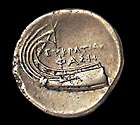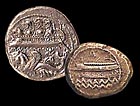These always constituted a separate kind of credit. Lenders normally had some experience of sea trade. A trader or naukleros, in other words a ship owner, would lend out money to buy cargo. The sum would normally be from 1,000 to 4,500 drachmae or more, with a mean average of 3,000 drachmae. This loan was in force so long as the voyage lasted. Trading voyages being a risky business, shipping interest rates were fairly high. In fourth-century Athens, they varied between 12.5% and 30%. As a guarantee against fraud, the ship (or to be more precise the ship's keel) and its cargo were given as security, and a written contract was drawn up stating the terms of the loan. Should the cargo be lost, responsibility for the loss lay with the lender. All that we know about how ship loans worked is packed into four speeches by Demosthenes in the mid-fourth century B.C. |

 |




